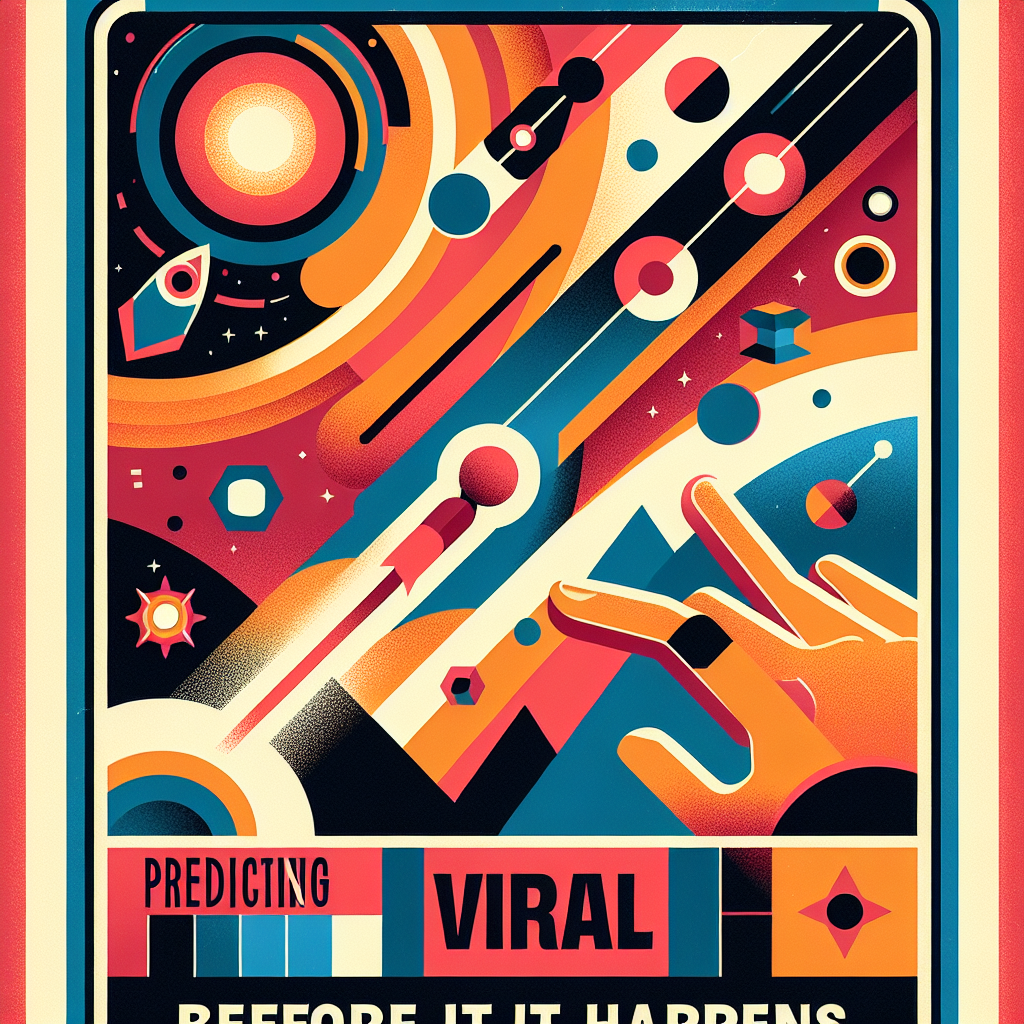“`html
Introduction to Virality in Digital Content
Have you ever wondered why certain pieces of content go viral while others don’t? While it may seem like a stroke of luck, the truth is more complex. Viral content isn’t about random chance. It’s about understanding the elements that encourage people to share.
In this article, we’ll get to the heart of what makes content go viral. We’ll discuss the critical components of viral content, from relatability to emotional triggers. We’ll then explore the role of data analysis, social media algorithms, and A/B testing.
Moreover, we’ll cover other important facets of viral content like timing, frequency, and collaboration with influencers. We’ll look into the benefits of community engagement, as well as the power of storytelling and original content.
Confused about how all these elements come together? Don’t worry! Join us as we unravel the mystery of virality, step by step. Let’s explore the world of viral content!
Can Viral Content Be Predicted?
Understanding Viral Content
Predicting viral content is a hot topic in digital marketing. Viral content refers to any piece of media that spreads rapidly online, reaching thousands, if not millions, in no time. Recognizing common traits can help in its prediction.
- Relatability: Content that’s relatable to a broad audience tends to get shared more.
- Emotional Trigger: Content evoking strong emotions, whether positive or negative, often goes viral.
- Shareability: Easily shareable content, such as short videos and infographics, tends to spread quickly.
Data Analysis and Trends
Data analysis is an essential aspect of predicting viral content. Examine patterns and trends in existing viral hits to uncover commonalities.
Using AI tools can help predict the virality of content based on these patterns. These tools assess factors like engagement rates and audience demographics.
Using Social Media Algorithms
Understanding social media algorithms is a key factor. Platforms like Facebook and Instagram prioritize content based on engagement.
Utilizing SEO techniques and tailoring content by platform increases virality potential. For example, a post with high engagement on Instagram tends to be shown to more users, according to a study by Convince & Convert.
Tapping into Influencers and Communities
Collaborations can amplify content reach. Leveraging influencers who have established audiences in your niche can increase the likelihood of virality.
Communities and groups within social platforms can also be strategic in disseminating content to the right audience, increasing engagement and shares.
A/B Testing Content
Testing different versions of content helps to understand what resonates with your audience.
| Content Type | Version A | Version B |
|---|---|---|
| Video Length | 60 seconds | 30 seconds |
| Image Style | Professional | User-generated |
Gather insights from these tests to refine future content and amplify viral potential.
Timing and Frequency
Post timing can greatly affect engagement levels. Sharing content when your audience is most active can increase interaction and sharing.
Moreover, posting frequency should align with audience appetite, ensuring optimal engagement without overwhelming them.
Analyzing these elements offers a roadmap to predicting, and potentially creating, viral content.
Nurturing your Audience for Viral Success
Maintaining Audience Engagement
Earning viral status for content certainly relies on widespread dissemination. However, it’s equally important to maintain audience engagement once they’ve clicked through your content. Sharing pertinent, engrossing content promotes audience retention, thereby increasing the chances of shares and comments – essentials for going viral. The golden rule here is always to value quality over quantity.
- Quality: Fresh, useful, and engaging content is more likely to compel audiences to share, thereby escalating the chances of going viral.
- Interactivity: Interactive elements like polls, quizzes, or contests can boost user engagement, turning passive audiences into active participants.
- Call to Action: Encourage audience participation with compelling CTAs, asking them to share, like, or leave a comment.
Leveraging Trending Topics and Hashtags
Viral content often capitalizes on current events or trending topics. A strategic alignment with trending themes, when it fits with your brand’s ethos, can quickly gain momentum. Additionally, leveraging popular hashtags on social media platforms can help your content get discovered by larger audiences.
The Place of Creative and Original Content
Breaking through the Noise
The online space is saturated with content vying for attention. For your content to stand out and make an impact, it needs to be original and innovative. Offering new perspectives or ideas can make your content compelling and shareworthy.
Storytelling for Connection
Storytelling is a powerful tool that can create strong emotional connections between your brand and the audience. By creating content that tells a story, you can evoke strong emotions that make your content not only memorable but irresistible to share. (Source: Buffer)
Agent of Change
Content that brings about change or advocates for a cause often tends to stir emotions and gain a shared response. Brands that use their platform to promote social, environmental, or political issues can stir up virality for their content.
Creating Shareable Content
It’s also essential to consider the format of your content. Here, “mobile-first content” is king. With the majority of social media users accessing platforms via smartphones, optimizing content for mobile sharing can make a significant difference in its potential virality.
Ensure your content is:
- Quick to load
- Easy to read/view on a small screen
- Straightforward to share across different platforms
Utilizing Social Proof
The Power of Testimonials
Featuring testimonials within your content can lend it credibility and foster trust.
Authentic user testimonials work as a stamp of approval from others, adding a sense of security and making people more likely to share your content.
Involving your Community
Creating a sense of community around your brand can be a driving force in viral content. Encouraging user-generated content or asking your audience for their views or experiences with your brand makes them feel involved and valued. This heightened engagement often translates into higher shares, helping propel your content into viral status.
What Makes Content Go Viral?
Elements of Viral Content
To predict which content might go viral, understanding its core components is vital. While relatability, emotional triggers, and shareability are key, additional factors also play significant roles:
- Novelty: Content that presents new ideas or unique perspectives can spark curiosity and encourage sharing.
- Humor: Funny content is a staple of viral media. People love sharing humor, which can lead to rapid dissemination.
- Utility: Content that is directly useful or informative, such as how-to guides or life hacks, often sees high engagement.
The Role of Distribution Channels
Beyond content quality, how and where you distribute your content can affect its reach.
– Cross-Platform Sharing: Utilize multiple social media platforms to increase exposure. Content that performs well cross-platform is more likely to go viral.
– Email Campaigns: Don’t underestimate the power of email marketing. Sharing content through emails can target specific audiences with a high conversion potential.
Influence of Cultural Moments
Aligning content with cultural moments or significant events can increase its viral potential:
– Seasonal Trends: Tie content to seasons or holidays to capture timely interest.
– Cultural Movements: Engaging with ongoing cultural narratives can tap into existing large-scale conversations online.
Quantifying Virality
Success in virality can be visualized using metrics:
| Metric | Indicator Value |
|---|---|
| Social Shares | 1000+ |
| Engagement Rate | 10%+ |
| Reach | 10,000+ audience |
Tracking these metrics helps discern what content features are effective and can guide future strategies.
Optimizing User Interaction
High levels of interaction help push content further into virality:
– Community Engagement: Participate in online communities related to your content to foster dialogue and interest.
– Responsive Feedback: Promptly engage with comments or discussions around your content to keep the conversation going.
For updated social media insights and strategies, check resources from [Social Media Examiner](https://www.socialmediaexaminer.com).
Understanding these varied elements can serve as a road map in crafting content with viral potential.
Making Content Go Viral
Crafting Shareable Content
Making content go viral isn’t just about luck—it’s about strategy. Here’s how to create content that gets shared widely:
– Concision: Keep your message short and to the point. Short videos, punchy headlines, or concise articles are more consumable and shareable.
– Visual Appeal: Incorporate eye-catching visuals. Infographics, compelling images, and high-quality videos grab attention and are more engaging.
Emotional and Psychological Hooks
Understanding the psychology of sharing can help in crafting content that resonates:
– Emotionally Charged: People share content that makes them feel something, whether it’s laughter, awe, or anger. Tap into these emotions for higher engagement.
– Identity Expression: Content that reflects a person’s identity or beliefs is more likely to be shared.
Optimizing for Platforms
Each social media platform has its unique flair and audience. Tailoring your content accordingly can boost its reach:
– Platform-Specific Formats: Platforms like Instagram favor visuals, whereas Twitter thrives on concise text. Adapt your content to suit the platform’s preferred format.
– Native Features: Use features like Instagram Reels or Facebook Stories to increase visibility. Platforms often promote content using their latest features.
Building Relationships with Influencers
Influencer partnerships can be a catalyst for virality:
– Micro-Influencers: While large influencers have reach, micro-influencers often have higher engagement rates. Collaborate with those who align with your brand values for authentic promotion.
– Long-term Partnerships: Engage in long-term collaborations rather than one-off promotions to build deeper relationships and trust.
Executing Timely and Relevant Campaigns
Timing is critical in content virality:
– Real-Time Marketing: Engage with trending conversations and real-time events to keep your content relevant and timely.
– Audience Activity Timing: Post content when your target audience is most active online to maximize visibility and engagement.
Analyzing Past Successes
Regular analysis can shed light on what works:
– Content Audits: Regularly review your content to analyze performance. Identify patterns in what went viral and replicate factors like topic or format.
– Iterative Improvement: Use metrics from past content to refine your strategy continuously. Tools like Google Analytics can provide insights into what’s working.
By understanding these elements, you can craft a strategic approach that maximizes the chances of your content going viral. For more advanced strategies, consider insights from [HubSpot](https://www.hubspot.com/marketing).
Incorporating these strategies will help to guide you in creating content with a higher potential for virality, leveraging both tried-and-true methods and platform-specific opportunities.
Wrapping Up: The Art and Science of Viral Content
Going viral is part art, part science. It requires keen observation to spot trends and understand audience preferences, and it calls for creativity to fashion engaging, shareable content. Though no formula guarantees virality, it’s clear that relatability, emotionality, shareability, and novelty give content a significant boost. But successful viral content needs more. Timely distribution, incorporation of trending topics, innovative storytelling, community involvement, testimonial utilization, creative and mobile-optimized content, and effective use of digital influencers and platforms all play part in the scheme of virality.
Content virality may be challenging to achieve, but with a strategic approach informed by the outlined principles and constant engagement with your audience, you stand a better chance of hitting that viral jackpot. Remember, attaining virality isn’t an end—it’s a means to amplify your message, build brand awareness, engage your community, and ultimately, drive conversions.
Frequently Asked Questions – FAQs
What factors can make content go viral?
The key factors include novelty, humor, utility, and emotional appeal. Other factors like timing, using social proof, and leveraging trending topics also come into play.
How can distribution channels affect a content’s virality?
A smart distribution strategy across multiple channels increases content exposure, thereby enhancing its virality potential. Channels include social media platforms, emails, and influencer networks.
How can social media influencers aid in content virality?
Influencers, with their established audiences, can magnify your content’s reach, thus increasing the likelihood of it going viral. Collaborate with those who align with your brand for authentic promotion.
Why should content be made mobile-friendly for better virality?
With a significant number of social media users accessing platforms via smartphones, optimizing content for mobile sharing can greatly enhance its potential for virality.
“`






